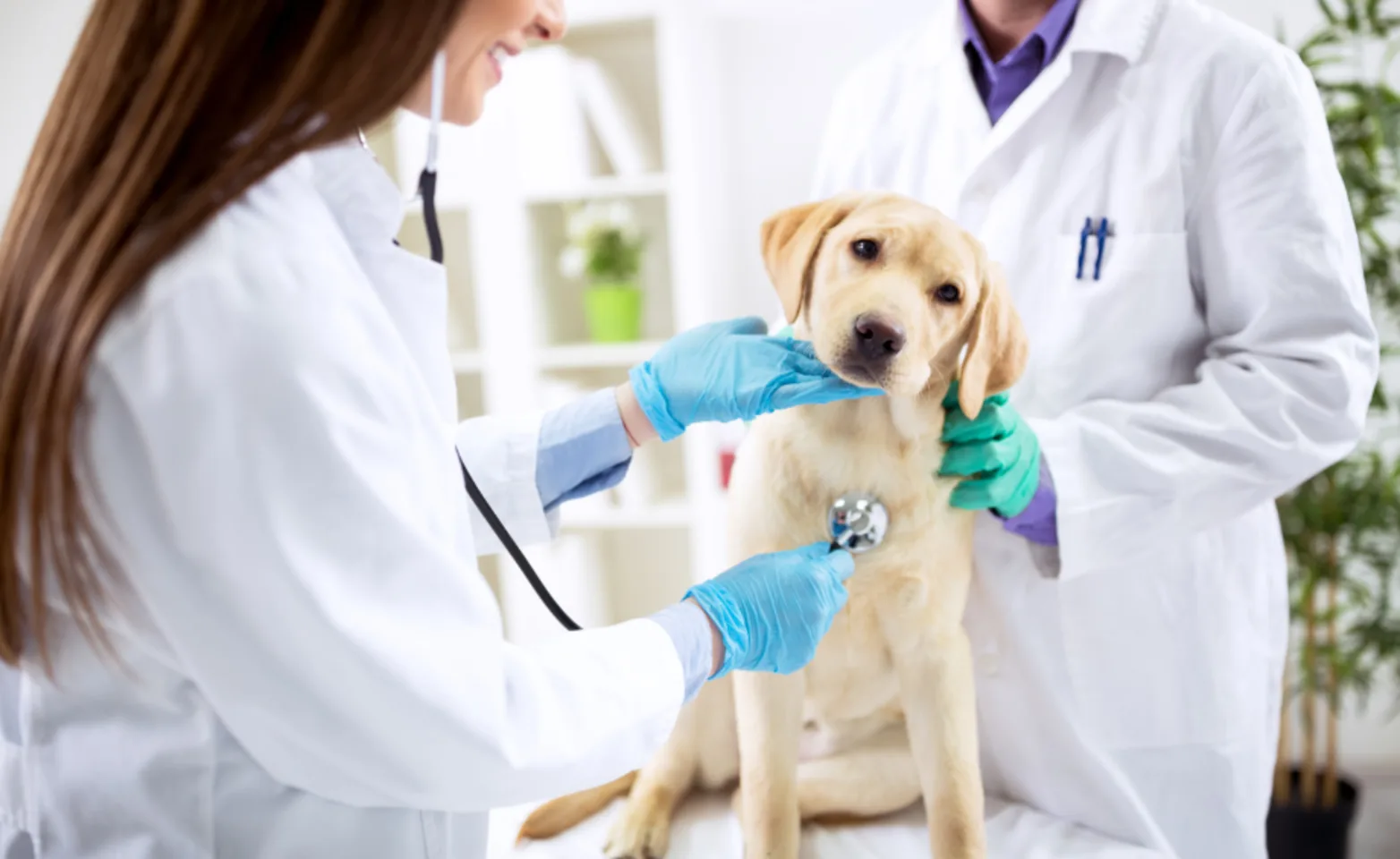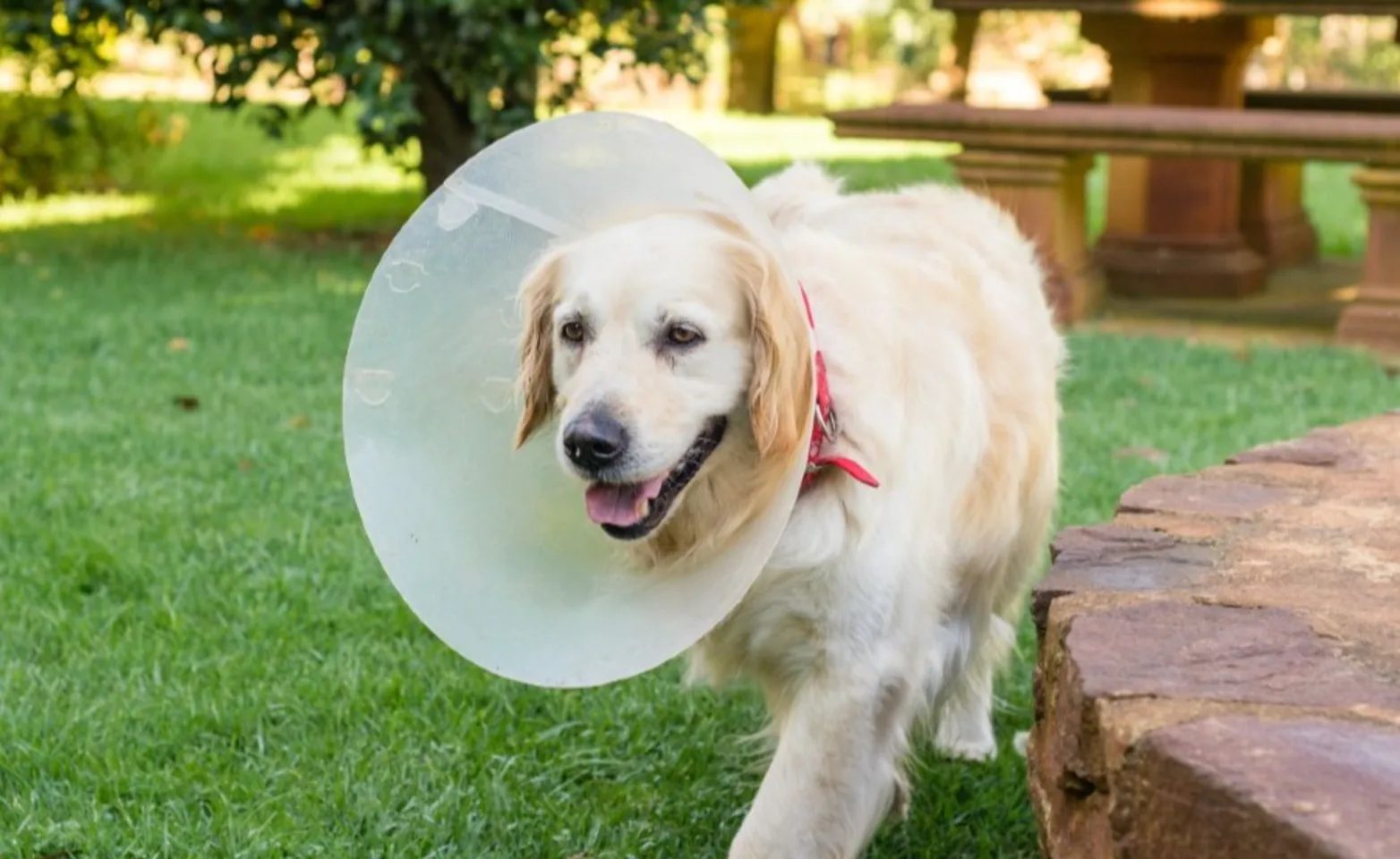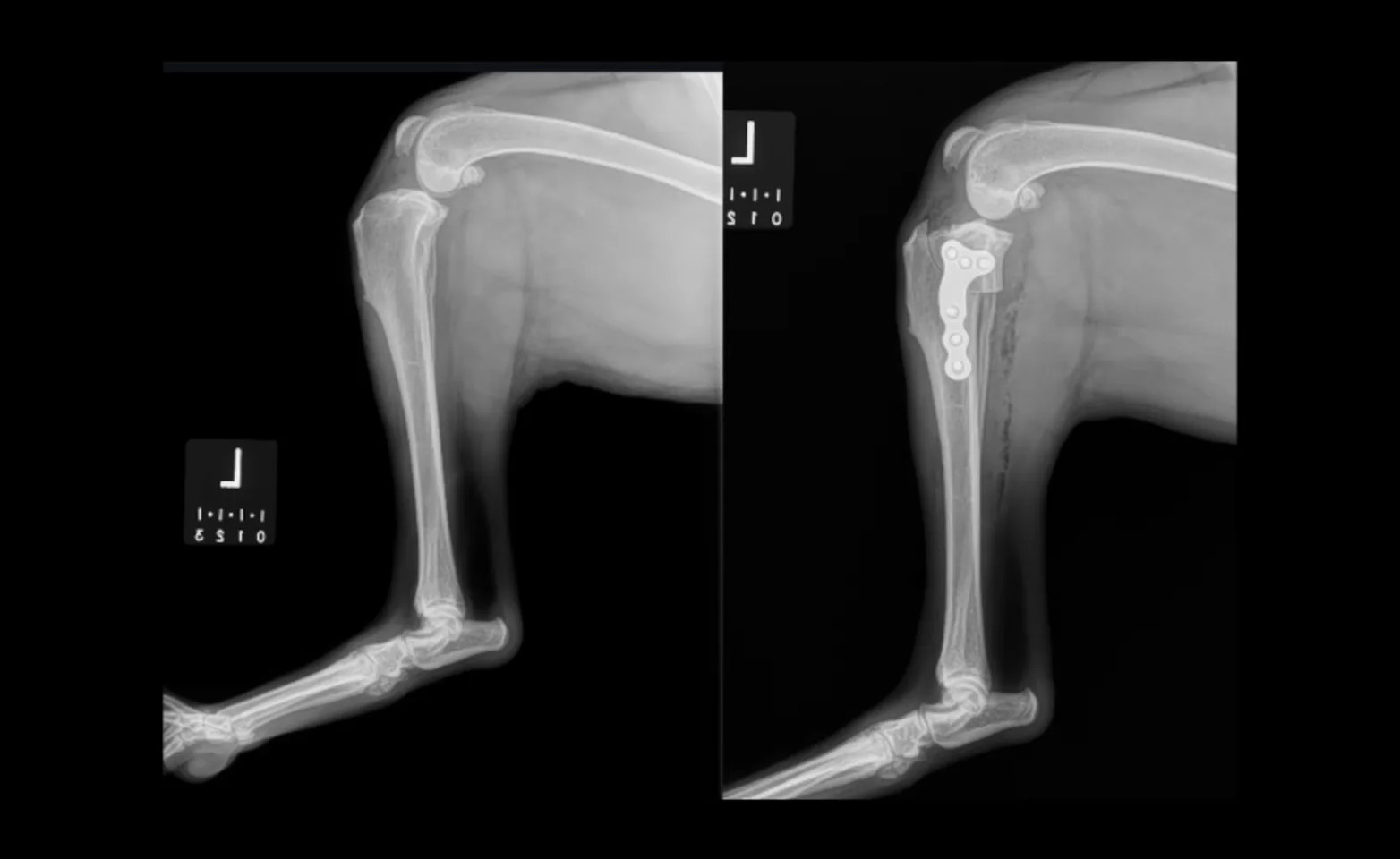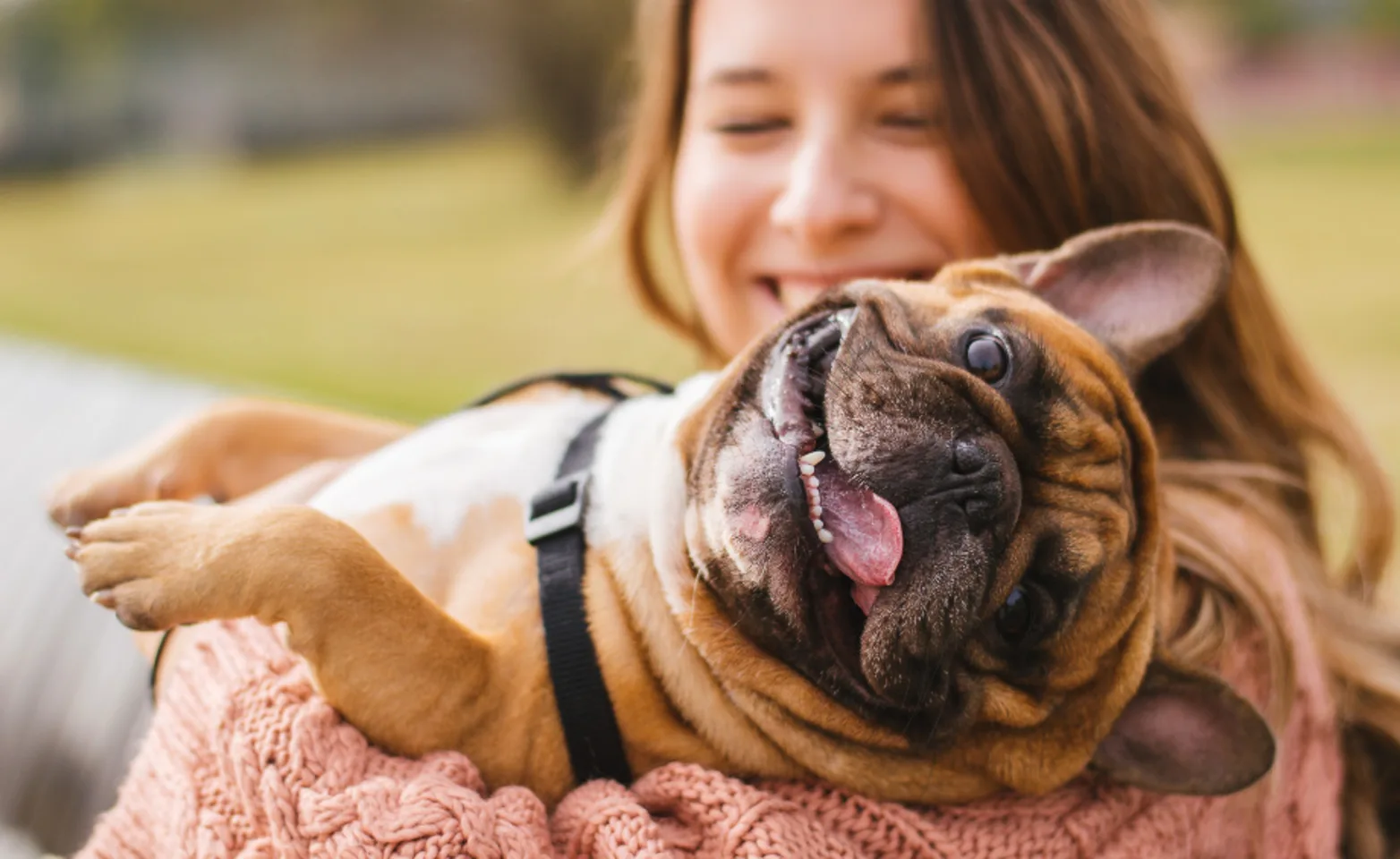Hopkinton Animal Hospital

Cranial Cruciate Ligament (CCL) Injuries in Dogs
CCL tears are one of the most common orthopedic injuries in dogs.
When the cranial cruciate ligament (CCL) ruptures, it causes significant knee instability that can permanently impair your dog’s mobility.
A Tibial Plateau Leveling Osteotomy (TPLO) is the gold-standard surgical technique for treating cranial cruciate ligament (CCL) injuries in dogs. The CCL is one of two ligaments that cross within the stifle joint (equivalent to the human knee) and is responsible for stabilizing the joint during movement.
When the CCL is torn or injured, it causes excessive motion between the femur and tibia, known as the cranial drawer effect. This instability leads to:
Joint inflammation
Pain and lameness
Progressive cartilage damage
You may notice your pet limping or favoring a hind leg, especially after activity. Left untreated, this instability contributes to degenerative joint disease (osteoarthritis) and can damage important structures like the meniscus, a cartilage pad that cushions the joint.
Why Stabilization Matters
Stabilizing the joint early—before arthritis becomes severe—is key to preserving your pet’s comfort and mobility. TPLO surgery eliminates the need for a functioning CCL by altering the biomechanics of the joint, providing long-term pain relief and preventing further damage.
Signs Your Dog May Need a TPLO
Sudden or persistent limping in a back leg
Recurring hindlimb lameness even after weeks of rest and pain medications
Difficulty rising, jumping, or using stairs
Clicking sounds from the knee
Swelling around the knee joint
Reduced interest in walks or play
Why Choose TPLO Surgery for your Best Friend?
TPLO surgery changes the angle of the knee joint, eliminating the need for the damaged ligament and restoring stability. The benefits include:
Proven success in restoring mobility
Ideal for large or athletic dogs
Reduces long-term arthritis risk
Faster predictable return to normal activity
Reduced muscle loss
Long-term joint stabilization
What to Expect at Our Hospital
Consultation & Diagnosis
We begin with a thorough orthopedic examination and may recommend digital X-rays or sedated joint evaluation.
Surgery Performed by Skilled Team
TPLO surgery is performed by our experienced veterinarian with specialized training in orthopedic procedures. Your dog will receive full anesthesia, monitoring, and pain management throughout the procedure.
Recovery & Rehab
Recovery typically takes 8–12 weeks. We provide clear post-op instructions, pain control, and rehab guidance to ensure the best healing possible.
What Is the Cranial Cruciate Ligament?
The cranial cruciate ligament (CCL) is similar to the human ACL. It connects the femur (thigh bone) to the tibia (shin bone) and helps stabilize the knee joint.
A rupture of the CCL is a serious injury that leads to:
Pain and lameness
Progressive arthritis and cartilage damage
Joint inflammation
Dogs of all sizes can be affected, but large breeds are at higher risk.
Young active dogs may tear their CCL during exercise or play.
Older dogs often experience ligament degeneration where even minor trauma can cause rupture.
Bilateral injuries are common—if one knee is affected, the other may follow. About 30- 50% of dogs will rupture both CCLs within 1-2 years of each other.
What Is a TPLO Surgery?
TPLO is a surgical procedure designed to stabilize the knee joint following a rupture or tear of the cranial cruciate ligament (similar to the ACL in humans). Instead of replacing the ligament, TPLO changes the angle of the tibia, which eliminates the need for the damaged ligament altogether.
This procedure is highly effective offering long-term joint stability and reduced arthritis development. While this procedure is especially effective for active dogs or larger breeds, TPLO surgery can benefit any size dog.
How TPLO Surgery Works
TPLO (Tibial Plateau Leveling Osteotomy) is a surgical technique designed to stabilize the knee joint by altering the angle between the femur and the tibia. This adjustment minimizes the forward thrust of the tibia during each stride, restoring functional stability to the joint.
During surgery, Dr. Peel makes a controlled semicircular cut across the top of the tibia. The cut portion of bone is then rotated to a new angle that neutralizes the shear force within the knee. Once aligned, the bone is secured using a specialized locking plate and screws, allowing it to heal in this corrected position. This realignment significantly reduces mechanical stress on the joint, lowers inflammation, and helps prevent long-term pain and osteoarthritis.
If a meniscal tear is identified during the procedure—a common accompaniment to cruciate injuries—Dr. Peel will carefully remove the damaged portion. The meniscus has poor blood supply and does not always heal well on its own, so removal of the torn area helps prevent continued pain and inflammation.
Before closing the incision, Dr. Peel administers a long-acting local anesthetic throughout each layer of tissue. This approach provides extended pain relief, ensuring your pet remains as comfortable as possible in the critical days following surgery.

What to Expect During TPLO Surgery
If TPLO surgery is determined to be the best option for your dog, we will schedule the procedure at a convenient time to help ensure an optimal recovery.
Here’s what the surgical process involves:
Your dog will be placed under general anesthesia.
Antibiotics and pain medications will be administered for comfort and infection prevention.
A surgical incision will be made to access the knee joint. The damaged cranial cruciate ligament will be completely removed.
The medial and lateral menisci—cartilage structures that act as shock absorbers—will be carefully examined. If either is torn, the damaged portion will be removed.
A curved cut will be made at the top of the tibia to adjust the angle of the tibial plateau.
The tibial plateau is then rotated to approximately 5 degrees and stabilized with a metal plate and screws.
Post-operative x-rays will be taken to confirm correct alignment and implant placement.
What a TPLO Procedure and Work-up Consists of
If your pet has a TPLO procedure with Hopkinton Animal Hospital it will include the following visits and services:
Initial exam and initial x-rays
Day of surgery
Surgery Check In: Between 7:30 to 8:30 a.m. at Hopkinton Animal Hospital,
Please fast your pet for at least 4 hours before then
IV
Pre-anesthetic blood work
Chest x-ray if needed/elected
Pain medications
Anesthesia
Detailed pre-op x-rays
Surgery including plate and screws
Post-op x-rays
Recovery day in the hospital
Take home pain medications and antibiotics
E-collar
10-14 days recheck
Physical exam or Telemedicine (emailed photo of incision)
10 weeks recheck
Physical Exam
Sedation if needed
X-rays
Pain Management for TPLO Surgery
We use a multimodal approach to keep your dog comfortable:
Pre-op and intra-op opioid medications
Long-acting local anesthetics
Continuous pain control during and after surgery
Thanks to this comprehensive pain plan, patients go home the same day to recover comfortably.
Recovery & Rehabilitation
Healing from TPLO surgery takes time, and success depends on proper post-operative care.
At discharge, you’ll receive:
A full set of written at-home care instructions
A rehabilitation plan for your pet
What to Expect:
Strict activity restriction for several weeks
Gradual return to walking and exercise
Most pets return to regular activity within 4–6 months
What Can I Do to Help Rehabilitate my Dog?
We recommend several gentle at-home rehabilitation procedures you can perform on your dog after TPLO surgery. Please reference your TPLO Discharge Instructions before beginning any of the rehabilitation exercises with your dog.

TPLO Surgery Success Rates
With over 20 years of proven results, TPLO surgery is one of the most researched veterinary procedures.
Compared to other procedures, dogs who undergo TPLO surgery recover more quickly and return to normal activity sooner. With TPLO surgery and proper rehabilitation, your dog will be able to recover from a CCL tear and regain full to near-full activity.
Success rates range from 90% to 95%, with most dogs returning to full or near-full normal activity within six months.
We minimize risks by:
Maintaining a sterile surgical field
Closely monitoring anesthesia with trained certified veterinary technicians
Prescribing post-op antibiotics to prevent infection
Guiding you through detailed aftercare instructions
Limiting activity after surgery is critical. Overexertion or falls may lead to soft tissue injury or implant failure.
TPLO Surgery Risks
As with any surgical procedure, TPLO does carry some risks. The complication rate is 8 to 11%.
Risk of infection
Risk of the implant failure
Bone healing slowly
As with any surgery on a joint, there is also an increased risk of osteoarthrosis and degenerative disease.
The benefits of TPLO surgery far outweigh the risks. The likelihood of the aforementioned risks is extremely low, while the likelihood of a fully functioning limb is over 90%. Many dogs have a torn CCL in both knees.
Studies have shown over a 10-fold increase in complication rate if surgery on both knees is performed at the same time. Due to this, we will not do bilateral knee TPLO unless Dr. Peel has approved it.

Ready to Help
Our team is happy to answer your questions about TPLO and help determine the right course of treatment for your dog’s knee injury. Early intervention leads to better long-term outcomes. At Hopkinton Animal Hospital, we are committed to helping your dog recover safely and comfortably. From surgery to rehab, we’re with you every step of the way.
Call us today at 603-487-6447 to schedule a surgical consult
